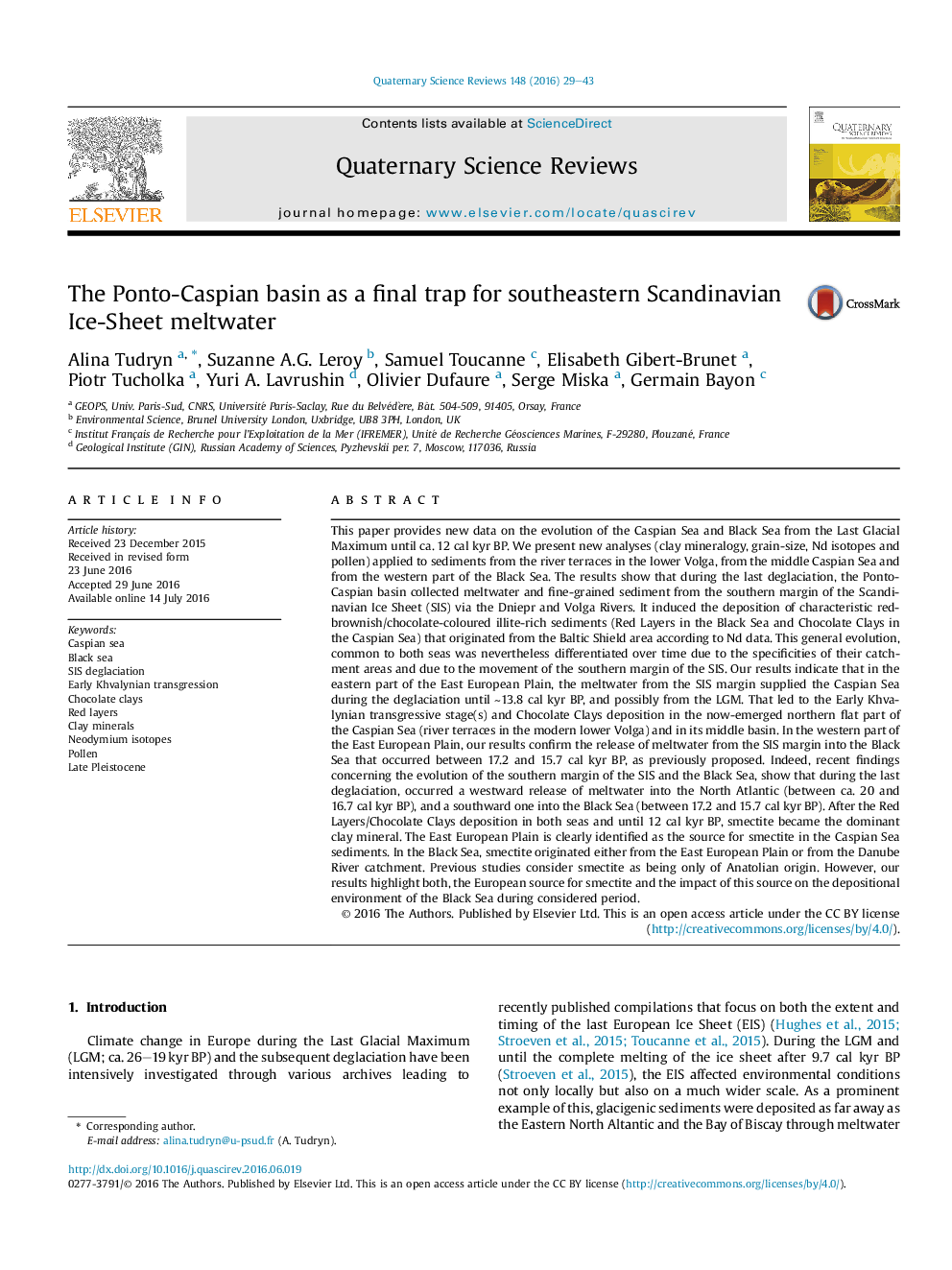| کد مقاله | کد نشریه | سال انتشار | مقاله انگلیسی | نسخه تمام متن |
|---|---|---|---|---|
| 6445368 | 1640787 | 2016 | 15 صفحه PDF | دانلود رایگان |
عنوان انگلیسی مقاله ISI
The Ponto-Caspian basin as a final trap for southeastern Scandinavian Ice-Sheet meltwater
ترجمه فارسی عنوان
حوضه پنتو-کاسپین به عنوان یک تله نهایی برای آب مایع یخچال جنوب شرقی اسکاندیناوی
دانلود مقاله + سفارش ترجمه
دانلود مقاله ISI انگلیسی
رایگان برای ایرانیان
کلمات کلیدی
موضوعات مرتبط
مهندسی و علوم پایه
علوم زمین و سیارات
زمین شناسی
چکیده انگلیسی
This paper provides new data on the evolution of the Caspian Sea and Black Sea from the Last Glacial Maximum until ca. 12 cal kyr BP. We present new analyses (clay mineralogy, grain-size, Nd isotopes and pollen) applied to sediments from the river terraces in the lower Volga, from the middle Caspian Sea and from the western part of the Black Sea. The results show that during the last deglaciation, the Ponto-Caspian basin collected meltwater and fine-grained sediment from the southern margin of the Scandinavian Ice Sheet (SIS) via the Dniepr and Volga Rivers. It induced the deposition of characteristic red-brownish/chocolate-coloured illite-rich sediments (Red Layers in the Black Sea and Chocolate Clays in the Caspian Sea) that originated from the Baltic Shield area according to Nd data. This general evolution, common to both seas was nevertheless differentiated over time due to the specificities of their catchment areas and due to the movement of the southern margin of the SIS. Our results indicate that in the eastern part of the East European Plain, the meltwater from the SIS margin supplied the Caspian Sea during the deglaciation until â¼13.8 cal kyr BP, and possibly from the LGM. That led to the Early Khvalynian transgressive stage(s) and Chocolate Clays deposition in the now-emerged northern flat part of the Caspian Sea (river terraces in the modern lower Volga) and in its middle basin. In the western part of the East European Plain, our results confirm the release of meltwater from the SIS margin into the Black Sea that occurred between 17.2 and 15.7 cal kyr BP, as previously proposed. Indeed, recent findings concerning the evolution of the southern margin of the SIS and the Black Sea, show that during the last deglaciation, occurred a westward release of meltwater into the North Atlantic (between ca. 20 and 16.7 cal kyr BP), and a southward one into the Black Sea (between 17.2 and 15.7 cal kyr BP). After the Red Layers/Chocolate Clays deposition in both seas and until 12 cal kyr BP, smectite became the dominant clay mineral. The East European Plain is clearly identified as the source for smectite in the Caspian Sea sediments. In the Black Sea, smectite originated either from the East European Plain or from the Danube River catchment. Previous studies consider smectite as being only of Anatolian origin. However, our results highlight both, the European source for smectite and the impact of this source on the depositional environment of the Black Sea during considered period.
ناشر
Database: Elsevier - ScienceDirect (ساینس دایرکت)
Journal: Quaternary Science Reviews - Volume 148, 15 September 2016, Pages 29-43
Journal: Quaternary Science Reviews - Volume 148, 15 September 2016, Pages 29-43
نویسندگان
Alina Tudryn, Suzanne A.G. Leroy, Samuel Toucanne, Elisabeth Gibert-Brunet, Piotr Tucholka, Yuri A. Lavrushin, Olivier Dufaure, Serge Miska, Germain Bayon,
